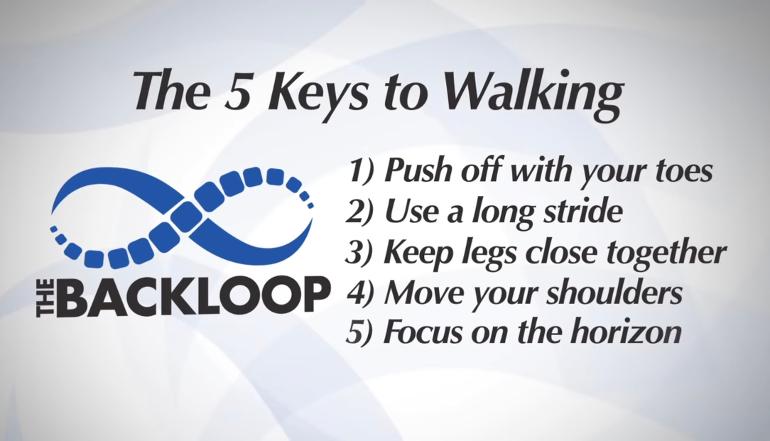Many of you know that I’ve been on a journey of increasing my walking range, as well as increasing my love for the act of walking itself.
It’s a journey, with its ups and downs, often hampered by re-occurring lower back pain that appears minutes into a walk. At the best times, it can wait until well into an hour-long walk; at the worst, it starts 5 minutes in.
Strangely enough, it (generally) does not appear when I’m running, which explains why I can think of a 60 min run as a nice little regular exercise, but just thinking of a 30 min walk can fill me with anxiety.
I’ve experimented on my walks with posture, positioning the pelvis differently, using the toes in my walking gait differently, rolling more fully, keeping my core engaged, and monitoring my whole walking cycle. All of this has helped to make me more conscious of what these little changes in posture and movement do to my back and its pain.
As part of this journey, I’ve pondered more and more on how flexibility/mobility affects lower back pain when walking.
The body is designed to be stacked. And when it’s stacked, or perfectly balanced upright, it does not need much muscle to keep upright. But any bent in that straight upward line disrupts that perfect balance, and with that disruption of that ideally stacked line comes the need for those small muscles to be constantly working to keep the body upright:
Is your weight pulling your spine forward? Well, then your little muscles in the lower back are trying to pull you constantly back in order to keep balance.
Is your lack of ankle mobility keeping you leaning back a tiny bit with each step? Then your upper body might compensate by leaning that unnoticeable amount forward, initiating further muscles to pull you back upright.
And so on and on. Anything disrupting that stacked line will mean additional small muscles will be harder at work keeping you upright, small muscles not designed to do a lot of work. But over time, minutes, hours, days, and years, those muscles will make you aware of the work they’ve been doing.
So I’ve been beginning to understand which exercises are the best to counter this weakness, often not just being about strengthening but also, or more importantly, about flexibility.
Some of these are
1) Pelvic tilts (all those Yoga bridges are great for this, and a better tilt straightens the spine, meaning it can stack more properly and in turn needing less muscles to keep one upright)
2) Ankle mobility (I’ve started a series focussing on ankle mobility over at S&F healthunlocked.com/strength... )
3) Spine mobility (remember all those Yoga and Pilates sessions that twist and round and roll the spine? They’re all great for this)
But also posture and the right form for walking are important. And that means you can exercise specifically those muscles to minimise walking-back-pain whilst walking!
So here is a little video I found that demonstrates how one can focus on a specifically spine-focussed technique that should minimise back pain.
1. Push with your toes - or walk with a spring in your step, rolling all the way through your toes and pushing off with your toes, which gives you that spring.
2. Proper stride length - surprisingly, many people experience less back pain when walking faster. That is also my experience. There is a logic to that to do with those glutes being fired, and helping your whole body (and core) to stay balanced. But just a bit without overstriding, which taxes the body in another way. And the continued use and strengthening of those glutes helps posture and movement in so many other ways, minimising the long-term lower back pain.
3. Legs close together - I’ve never had an issue with this, but I know many people do. The leg and foot position is obviously vital for proper alignment, and not being able to align these will undoubtedly heighten the risk to the spine and back, letting you know ( at some point in one’s life) of the burden of compensating for this.
4. Move your shoulders opposite your legs - Until recently, I’ve never given my shoulders much thought when walking, focussing rather on arm swing-movement. But when one thinks about this, it’s logical that a shoulder movement while walking allows you to practice spine flexibility whilst keeping that straight line stacked by twisting and not bending. It’s a movement that practices your flexibility, maximising your ability to reduce back pain.
5. Focus with your eyes on the distant horizon - because, if you don’t, if your eyes look down, it’s more likely your head is down. And that means it’s out of alignment. And in turn, that means the body will try to compensate in some manner, maybe by leaning that tiny amount back, or reducing the stride, and potentially needing more muscles to ensure that upright position. Over time, that leads to those small muscles being over-used, e.g. risking … yes… back pain.
So here is the 7-min video:
Dr Chuck Tillitson, D.C. (7 min) How to walk correctly and fix your lower back pain. Take the Five Easy Steps
And if you have any tips on how to minimise lower back-pain while walking, let us know!
